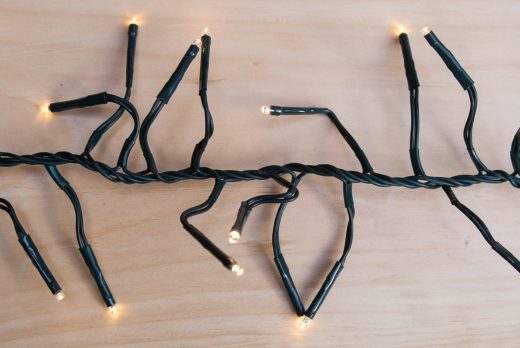The best Christmas lights
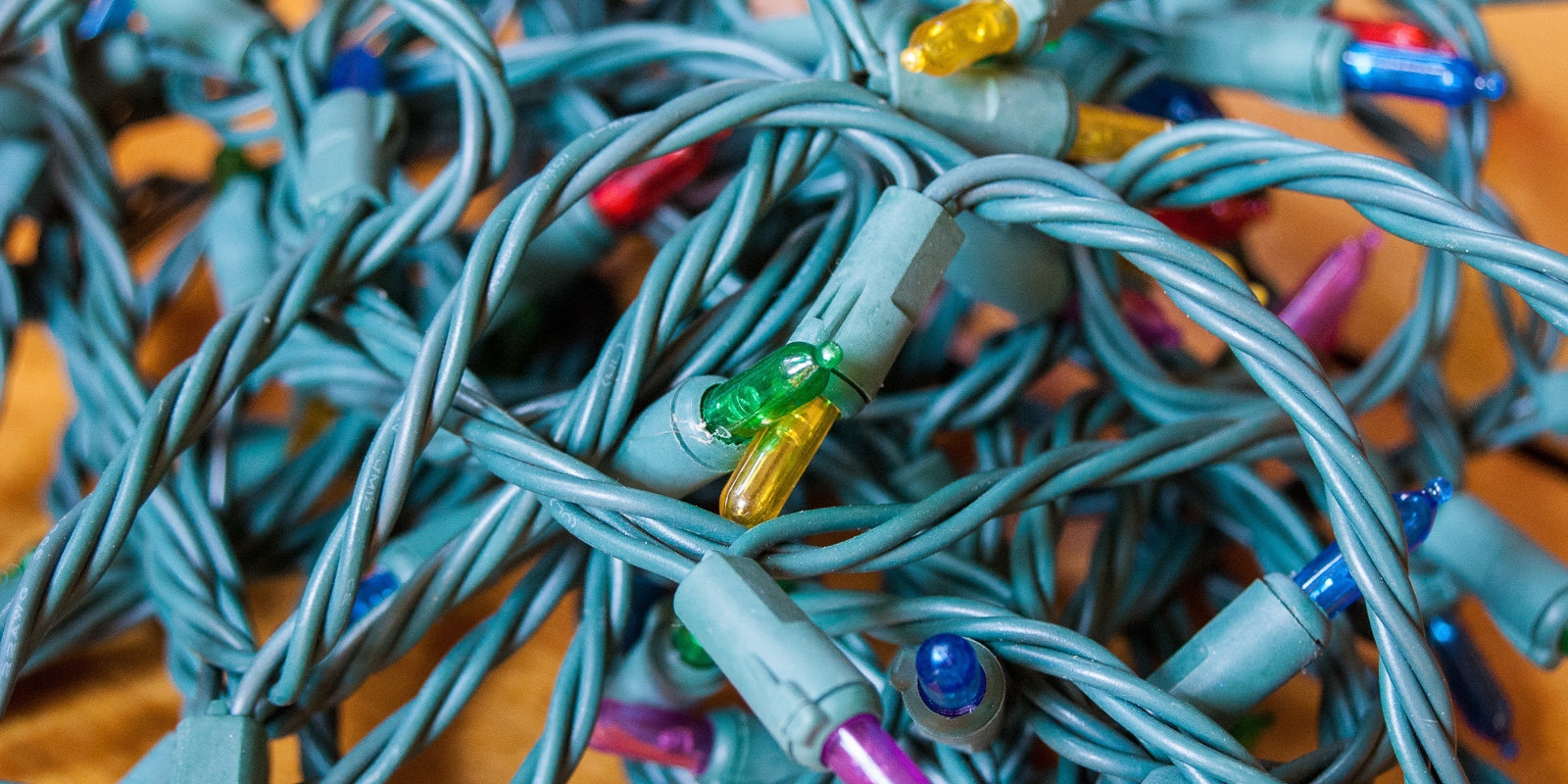
By Doug Mahoney
This post was done in partnership with Wirecutter. When readers choose to buy Wirecutter’s independently chosen editorial picks, Wirecutter and Engadget may earn affiliate commission. Read the full Christmas lights guide here.
After spending over 70 hours researching Christmas lights, interviewing experts, and testing 20 strands of lights side by side, we’ve found that GE’s Energy Smart Colorite LED Miniature Lights (available in multicolor strands of 50 bulbs or 100 bulbs and in warm white strands of 50 bulbs or 100 bulbs) are the best all-around indoor Christmas lights. This is the fifth year we’ve named these GE lights as our pick, and we can’t find any lights that match their color quality and their ready availability at Home Depot.
Like all LED models, the GE Colorite lights are safer, more durable, and longer lasting than traditional incandescent lights, and they barely draw any electricity at all. Among the LEDs we looked at, we found that the GE Colorites’ hues of warm white and especially multicolor most closely matched those of traditional incandescents—tested side by side at 4 or 5 feet away, they’re very difficult to tell apart. These GE lights also have a tidy wire that doesn’t curl or twist, simplifying the task of draping them through a tree or storing them in the off-season. The bulbs should last for at least 10 holiday seasons, and individual bulbs are replaceable if they go out (or you can just leave those; the rest of the strand will stay lit). The price is average for LED bulbs, although these do cost more than comparable incandescents. And they aren’t the best for outdoor use, because their design isn’t totally watertight. Overall, though, these lights offer better benefits and have fewer drawbacks than any other indoor lights we tested. They are available in multicolor (50 bulbs or 100 bulbs) and warm white (50 bulbs or 100 bulbs).
The GE lights have sold out quickly the past few years, so if that happens again, we recommend Christmas Designers T5 Smooth LED Lights (available in warm white, multicolor, or solid color). In our tests the multicolor lights looked as good as the GEs, while the warm whites had a cooler tone that was a little further from the coziness of an incandescent.
For outdoor use, we recommend the 5mm Wide Angle Conical LED Lights from Christmas Designers, available in warm white, multicolor, or single color in a variety of lengths and bulb spacings. These lights offer all of the benefits of LEDs as well as a design that makes each bulb impervious to moisture for weeks in the snowy, sleety, rainy outdoors—we confirmed that by leaving a lit set submerged in a water-filled bucket all day. We liked the warmth of the color, the bright light output, and the manageable wires. Due to the unusual design of the wide-angle bulb, the brightness of each changes dramatically depending on where you’re standing, giving the lights texture and depth when they’re draped over a tree or twisting around a porch post. Because they’re likely to be exposed to harsh exterior conditions, these lights will have a shorter lifespan than indoor LEDs, but you can still expect six or seven seasons out of them.
These lights are ideal for larger displays: Because of their low electricity usage, you can connect a stunning 43 strands together and run them on a single outlet (with incandescents, you can connect only five or six, depending on the manufacturer). The only major drawback with these lights is that they’re a bit too bright for indoor use. Pro lighting designers and other experts consistently named this particular type of bulb as the ideal choice for outdoor holiday-lighting displays.
If our outdoor pick is sold out, we recommend Christmas Lights Etc’s Wide Angle 5mm LED Lights as a runner-up. In most ways they’re identical to the Christmas Designers lights, but they’re not as bright. They are a bit cheaper than our outdoor pick, though.
Last, if you’re not ready to give up the unique warm twinkle of incandescents for an indoor tree, the Incandescent Christmas Lights from Christmas Designers are our favorites. These mini-light sets emit the warmest overall light, and like our other picks, they have an easy-handling wire. They also cost less than half as much as an LED strand, but they’re not as durable, they’re less efficient, and they won’t last as long.
Incandescent lights are typically rated for 2,000 to 3,000 hours of use, whereas our main recommendation, the GE Energy Smart Colorite LEDs, have an average life of 20,000 hours. Keep in mind that this is just the bulb life—the figure doesn’t even take into account how fragile and easily breakable an incandescent filament is. (A few years ago, I had to throw out half my incandescent strands due to nonworking bulbs.)
Why you should trust us
It wasn’t easy to pick out these specific models from the seemingly infinite selection of Christmas lights in the world. But we reached our conclusions with the input of several people who live and breathe lights: Ben Orr, owner of Northern Seasonal, who has been professionally installing holiday lighting in the Chicago area since 2005; Jason Woodward, the director of ecommerce at Christmas Designers, a retailer specializing in holiday lighting; and John Strainic, GE‘s general manager of North America consumer lighting.
Those experts helped us identify the best models, which we then assessed for color quality, using the traditional incandescents as benchmarks. For that portion of the testing, we consulted Susan Moriarty, executive creative director and founder of the Boston-based creative agency The Soapbox Studio, who has 20 years of experience as an art director, designer, and photographer.
How we picked and tested
We concentrated our research and testing strictly on nonblinking miniature lights, the traditional, small, stranded Christmas lights with a clear or semiclear bulb and a candle shape. An article at DIY Network says that even though larger bulbs are growing in popularity, “mini lights have been by far the most popular during the past decade.” They’re the standard, and we wanted to focus on the lights that most people will be using, rather than those with a lesser following. Still, we do have some thoughts on the larger-bulb lights, and on other bulb sizes that didn’t make the cut. During our research, we also found that blinking lights are a very small minority of available lights, so we stayed with the type that remains lit at all times.
Once we dug into our options, we soon realized that our recommended lights would be fully rectified LEDs and not traditional incandescents. As Northern Seasonal’s Ben Orr, the lighting installer, told us, “LED lights allow you to do more with less.” They’re more durable, they’re safer, and you can connect together a much higher number of strands without any risk of tripping a breaker or a GFCI outlet. They also just plain ol’ last longer and use a fraction of the electricity that incandescents use. In an article on the Christmas Designers website, Jason Woodward writes that “the benefits offered by LEDs are almost as significant as the benefits that incandescents provided over candles.” There’s no question that LEDs cost more than incandescents (they’re at least twice the price), but we believe that the long-term benefits are worth that added cost.
Some LEDs are better than others, however. All LED Christmas lights blink on and off many times per second, like a fluorescent light. The ones that are fully rectified, or full-wave, light up at a rate of 120 times per second, which is faster than the eye can detect. Lights that are known as half-wave, sometimes called non-rectified, blink 60 times per second, which can create a dizzying flickering effect. Orr told us that when a non-rectified strand is moving, the flickering becomes more apparent, and we confirmed this effect during our testing: Just by giving a non-rectified strand a slight jiggle, we made the lights take on a strobe effect that was very unpleasant to look at. In our tests, even when they were not moving, those lights seemed to have a harshness, an electronic feel, that the rectified lights didn’t have.4
LEDs, especially fully rectified ones, definitely represent more of an investment than incandescents. Most of the incandescents that we looked at sold for 5¢ to 9¢ per bulb, while the LEDs were in the 20¢ range, putting them at just over twice the price. Still, with all of the benefits that LEDs provide (durability, safety, greater design flexibility), they’re gaining popularity. According to an Associated Press article from late 2013, “Wal-Mart is devoting half its shelf space for Christmas lights to LEDs.” The article also notes that “Costco isn’t selling any incandescent lights at all, while General Electric – a player in the Christmas light market for more than a century – expects two out of every five strands of lights it sells this year will be LEDs.” Christmas Designers also does lighting installations, and Woodward told us that each year the company uses, on average, 60,000 sets of lights, all LEDs. Given the fact that LEDs are roughly two to three times the cost of incandescents, that’s a strong endorsement.
For outdoor lights, our experts directed us toward a specific style of LED, 5-millimeter wide-angle conicals. The bulbs on these lights are stubby and don’t have the homespun look of the small glass candle found on other mini lights. They are much brighter than regular mini lights (both LED and incandescent), and the unique shape of the bulb adds depth and complexity to the lights’ appearance. As Orr told us, this shape allows the strand to “refract the light and create a cool look depending on the angle of view. It appears that some are brighter than others and it adds contrast.” Orr, who specializes in exterior displays, added that 5 mm wide-angle lights are generally his favorite light. And Christmas Designers, in a video dedicated to the bulbs, says these lights are “by far the most popular set we sell.”
But as with regular LED bulbs, the color of the light is a concern. We figure that if you’re reading this guide, you’re probably interested in replacing an old set of incandescent lights—but even if you want something more efficient and durable, you don’t want to give up the traditional lights’ familiar warm glow. Unfortunately, that is an issue with LEDs.
Both Orr and Woodward warned us that LEDs simply do not look like incandescents. Due to improvements in the technology, many companies manufacture a “warm white” color that, depending on the quality of the LED, can closely mimic, but not fully achieve, the pinpoint sparkle of an incandescent. Orr stressed that “LED technology varies throughout the industry, and a warm white from one supplier can vary in hues and color drastically from another.” He even suggested buying strands from a few different manufacturers to compare them and see which hue you like best before making a large purchase. Once you find something you like, he said, buy from only that manufacturer. Our testing confirmed that there is a tremendous variety in LED color hues, from the fantastic to the terrible.
In selecting the strands we wanted to test, we searched all of the larger online retailers (Amazon, Home Depot, Lowe’s, Target, Walmart). Orr told us that he purchases his lights from a specialty retailer, so we also looked at lights from Christmas Designers, Christmas Lights Etc, and Christmas Light Source. These specialty retailers deal only in Christmas lights and focus on the needs of the professional, though they certainly have no problems with a regular shopper purchasing from them. Each store seems to have its own in-house brand of lights, so you won’t see them selling Martha Stewart or GE lights. We’ve found that these companies are extremely knowledgeable about lighting, and in general their items are very nice.
We dismissed companies that had overall poor reviews (Holiday Time), strange or incomplete bulb selections (EcoSmart), or suspiciously low pricing (Home Accents). Other companies, like Hometown Evolution, AGPtek, and Deneve, fall more into general exterior decor and don’t have a very good selection of Christmas lights. AGPtek, in particular, deals only in solar-powered or battery lights, which are more of a specialty item, and we wanted to concentrate on general tree and exterior lighting.
Our original testing consisted of 16 sets, including colored and white mini lights, both LED and incandescent. We also tested a number of 5 mm wide-angle conical LEDs, since our experts recommended them for exterior use. Then, in 2015, we looked at two new sets from Christmas Designers, the T5 Smooth LED Lights in both warm white and multicolor.
We’ve also spent a little time investigating and testing other styles of lights, most notably cluster lights and the larger C7 and C9 bulbs. We have more information on those below.
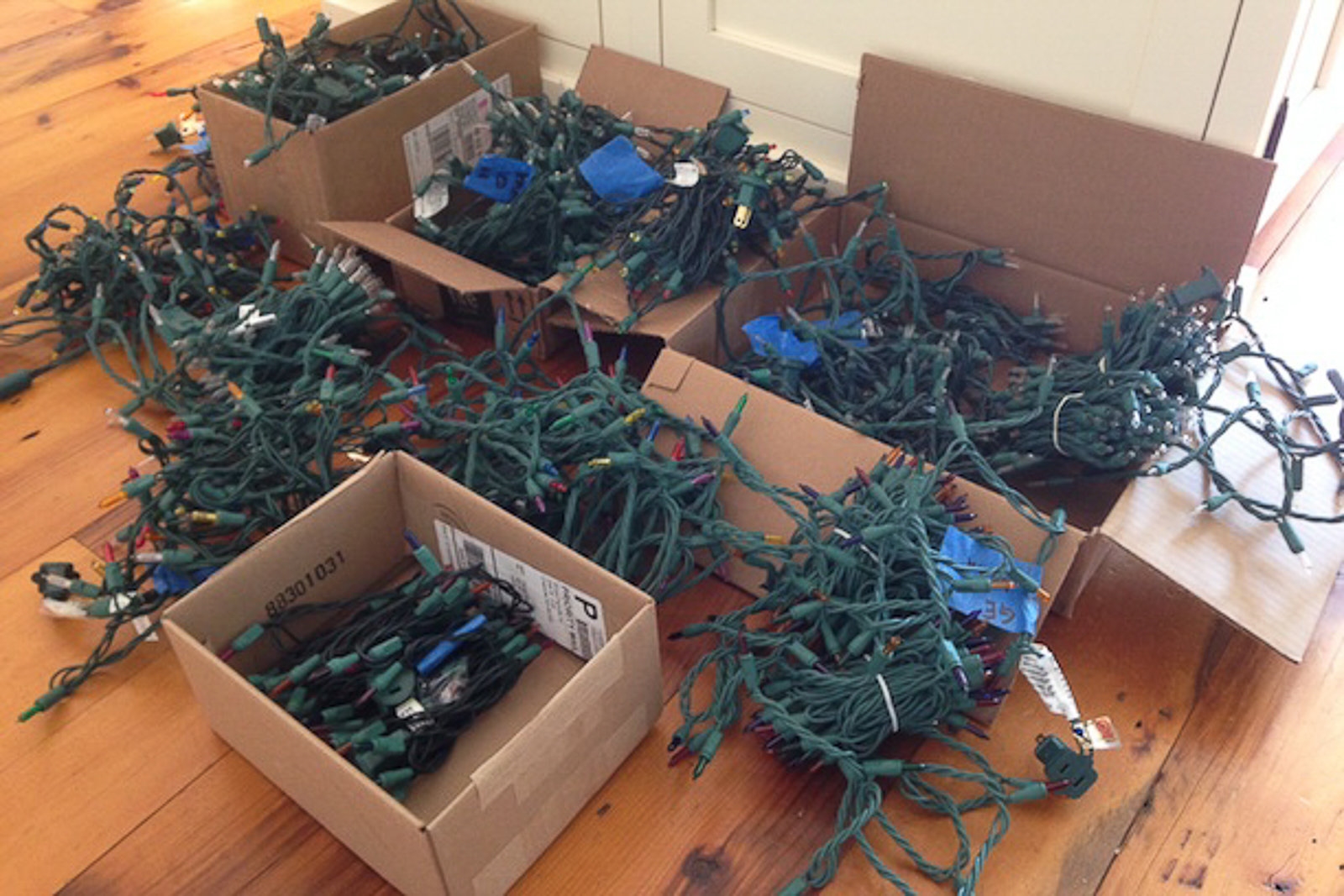
To evaluate the lights, we wound and unwound them, draped them over and into Christmas trees and rhododendrons, and tucked them in and out of deck railings. Basically, we tried to use the lights how they’re intended to be used. We tested the weather impermeability of the exterior lights by plugging them in and sinking the strands of lights into a 3-gallon bucket of water. While this test was a bit extreme, it’s certainly possible that any set of exterior lights will end up in a puddle or draped in a gutter.
Overall, we found that the wire quality has a lot to do with the success of a strand of lights. Some of the tested lights had tidy, close-knit strands of wire, while others were loose and messy. Some wires needed untwisting before use, like an old phone cord, and still others continued to accordion back on themselves no matter how we tried to stretch them out and lay them flat.
We also assessed each strand for color quality, using the incandescent strands as a benchmark, with the input of Susan Moriarty, executive creative director and founder of The Soapbox Studio. She’s a die-hard fan of the warmth that incandescent Christmas lights emit, so we asked her to compare the classics against new LEDs. Even though Moriarty did her evaluations in a blind fashion, she consistently chose along brand lines, a result that backed up Orr’s suggestion to select a single manufacturer and stick with it.
Our pick for indoor lights: GE Energy Smart Colorite LED Miniature Lights
For indoor use, we recommend GE’s Energy Smart Colorite LED Miniature Lights, which are available in multicolor (50 bulbs or 100 bulbs) and warm white (50 bulbs or 100 bulbs). These bulbs offer all the benefits of LED lights, including high durability, zero heat output, and a long life expectancy, but one attribute sets them apart: Of everything we tested, GE’s Colorites came the closest to replicating the glow of incandescents. This was particularly true with the warm white bulbs, which were impressive in their color quality. These lights also have a nice wire that’s easy to handle and to drape through a tree or railing. And unlike some other LEDs, they don’t flicker.
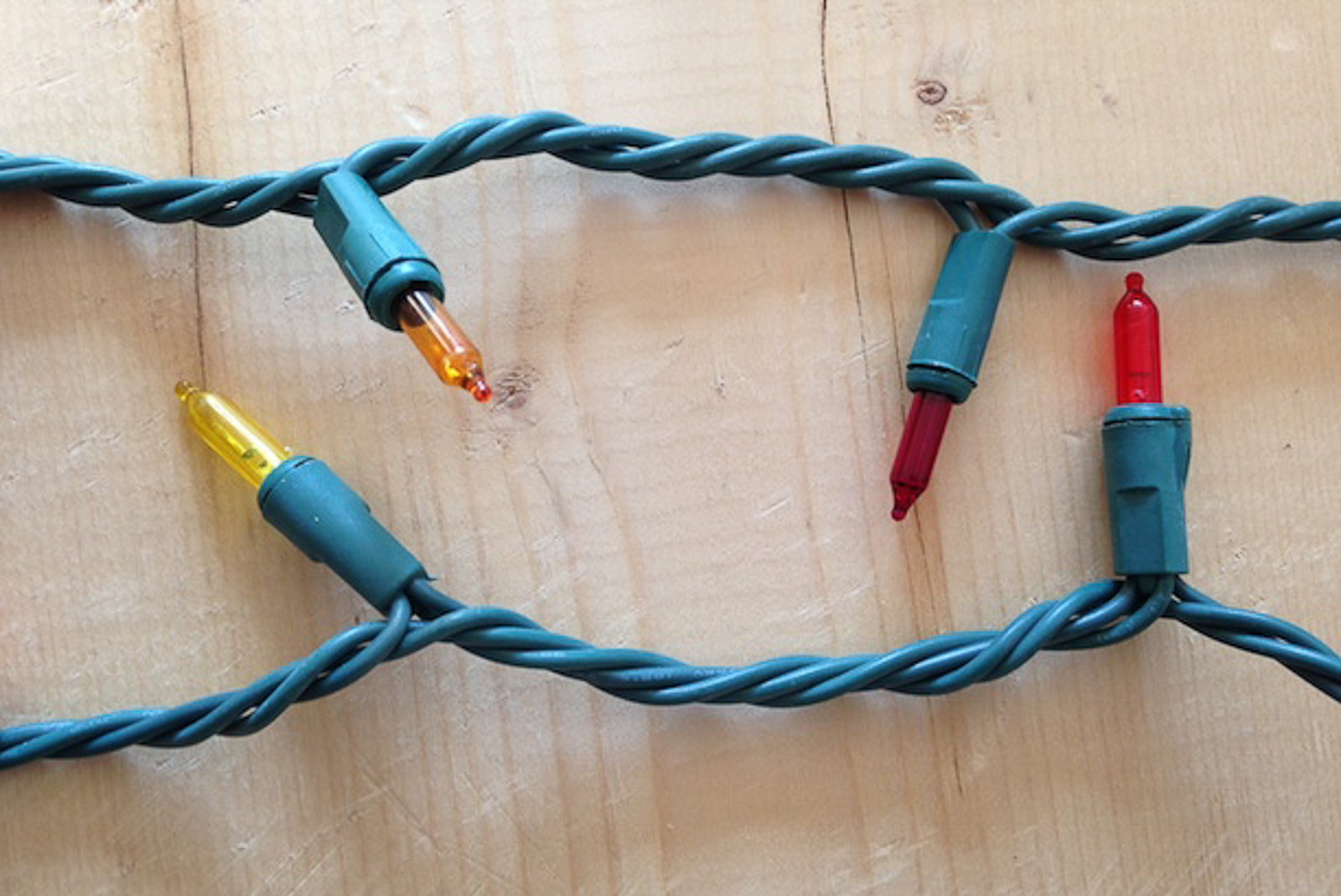
In examining all of the LED strands, we concluded that the Colorites were the clear winner, giving off a warm tone that was closer to the look of an incandescent strand than any of the other LEDs we considered. It wasn’t a 100 percent perfect match, though. Viewing the Colorite LEDs next to some GE incandescent lights, we noted that the LEDs appeared brighter; this happens because, at some viewing angles, the diode illuminates the entire colored bulb, whereas with an incandescent, only the pinpoint of the filament is lit, giving it that twinkly, sparkly look. Note, however, that we made this distinction while specifically looking for differences between the bulbs. Once we were about 5 feet away from them, it became extremely difficult to tell these LEDs apart from the strand of incandescents. Like a lot of people, we were initially resistant to LED Christmas lights. But we were impressed with the look of the GE Colorites in our testing, and we would be happy to put them on a tree at home.
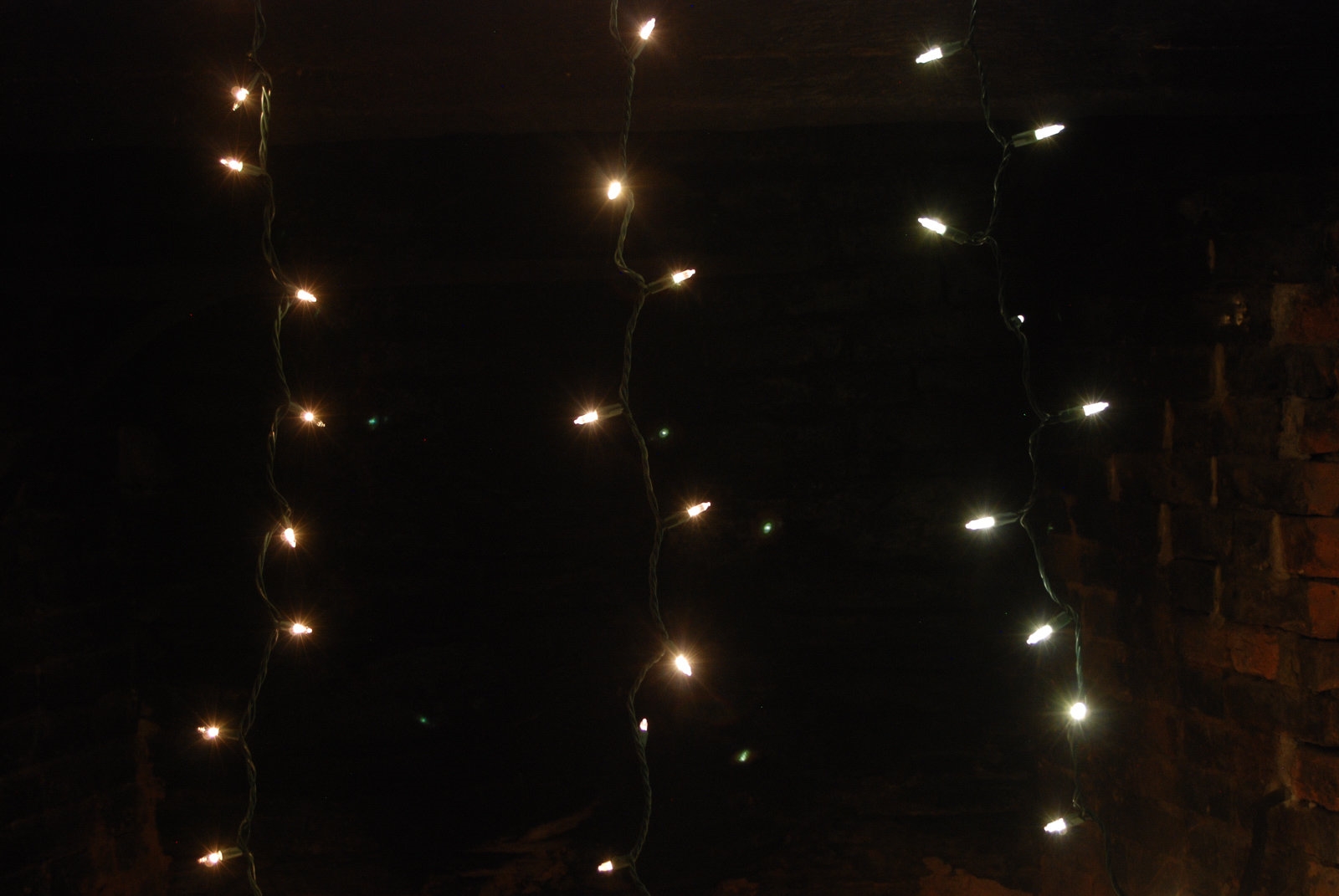
We also liked that the GE Colorite wire strands were easy to manage. In our tests, they were tidy, and they had a nice flex to them. Out of the box, the lights unraveled nicely. And unlike a lot of the others we tried, they needed no twisting to stretch and flatten them out.
The GE Colorite LEDs are rectified, also known as full-wave, so you won’t have any flickering issues as you would with lesser-quality LEDs. It also means that you can use these lights with a dimmer or a lighting controller.
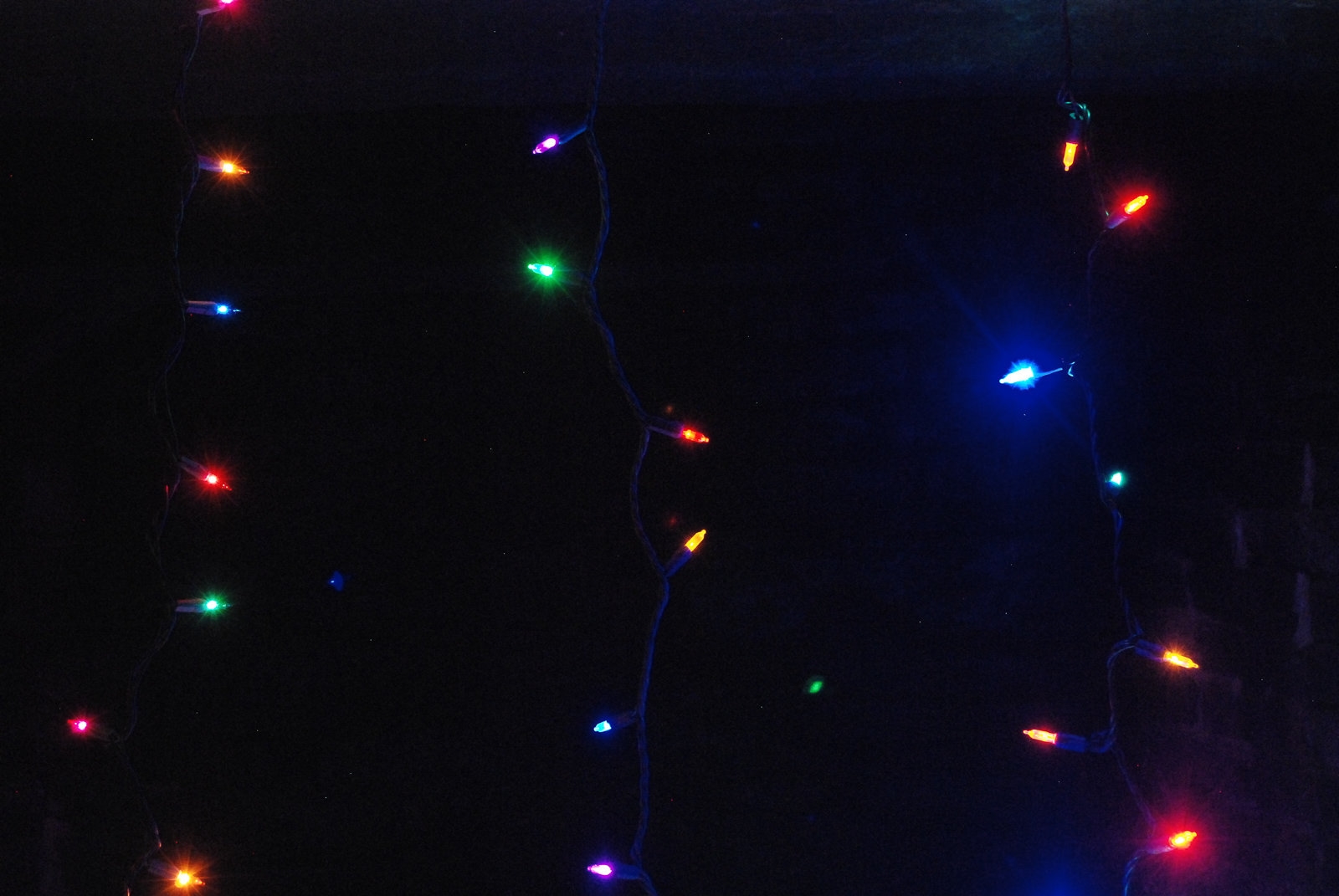
The GE Colorite LEDs are also durable, and they should withstand the annual boxing and unboxing process without a hitch. In an LED bulb, the light-emitting diode is encased in a block of plastic, so unlike with a delicate incandescent filament, knocking a bulb out of commission would take quite a bit of effort. Although we don’t suggest that you jump rope with your strands of LED lights, we do believe that they will be able to handle a drop. When we asked Jason Woodward of Christmas Designers about the lifespan of indoor LEDs, he told us, “High-grade LEDs haven’t been around long enough to really know how long they will last on an indoor application, but it should be at least 10 years.” That longevity should be good news for anyone who has ever gotten out their incandescent lights from the previous year, found a bunch of them mysteriously half-working or suffering from too many blown bulbs, and ended up throwing a bunch of them away.
GE’s Colorite lights have a feature called Constant On, which means that if a single light becomes loose or damaged, the rest of the strand will stay lit. The bulbs are also replaceable; you just pop one out and put a new one in.
Like other LEDs, the GE Colorites emit zero heat when lit, so you can sleep easy while they’re lighting up your dessicated tree in mid-January. Incandescents, on the other hand, produce heat and can get quite hot. While newer incandescents are highly unlikely to ever start a tree fire, they could give an unsuspecting toddler quite a jolt.
Because of the Colorite lights’ low energy usage, you can string together up to 25 sets, more than enough for even the most ambitious indoor displays.
At this writing the GE Colorites cost roughly 20¢ per bulb, which is right where most good-quality LEDs land.
Indoor: Flaws but not dealbreakers
Although the GE Energy Smart Colorite LED Miniature Lights impressed us more than the others in both quality and overall color, we did discover a few drawbacks to these lights.
First, they don’t have stackable plugs, the kind of design where the male plug has a female outlet on the back side of it. With stackable plugs, you can piggyback multiple strands directly on the same outlet—a useful feature for outdoor displays where you might be lighting bushes in opposite directions on either side of a single outlet, but less of a necessity indoors. The lack of such a plug design on the Colorites could make for a crowded wall outlet, but a small power strip will solve the problem. You can still attach the Colorites end to end, just as you would any other set of Christmas lights.
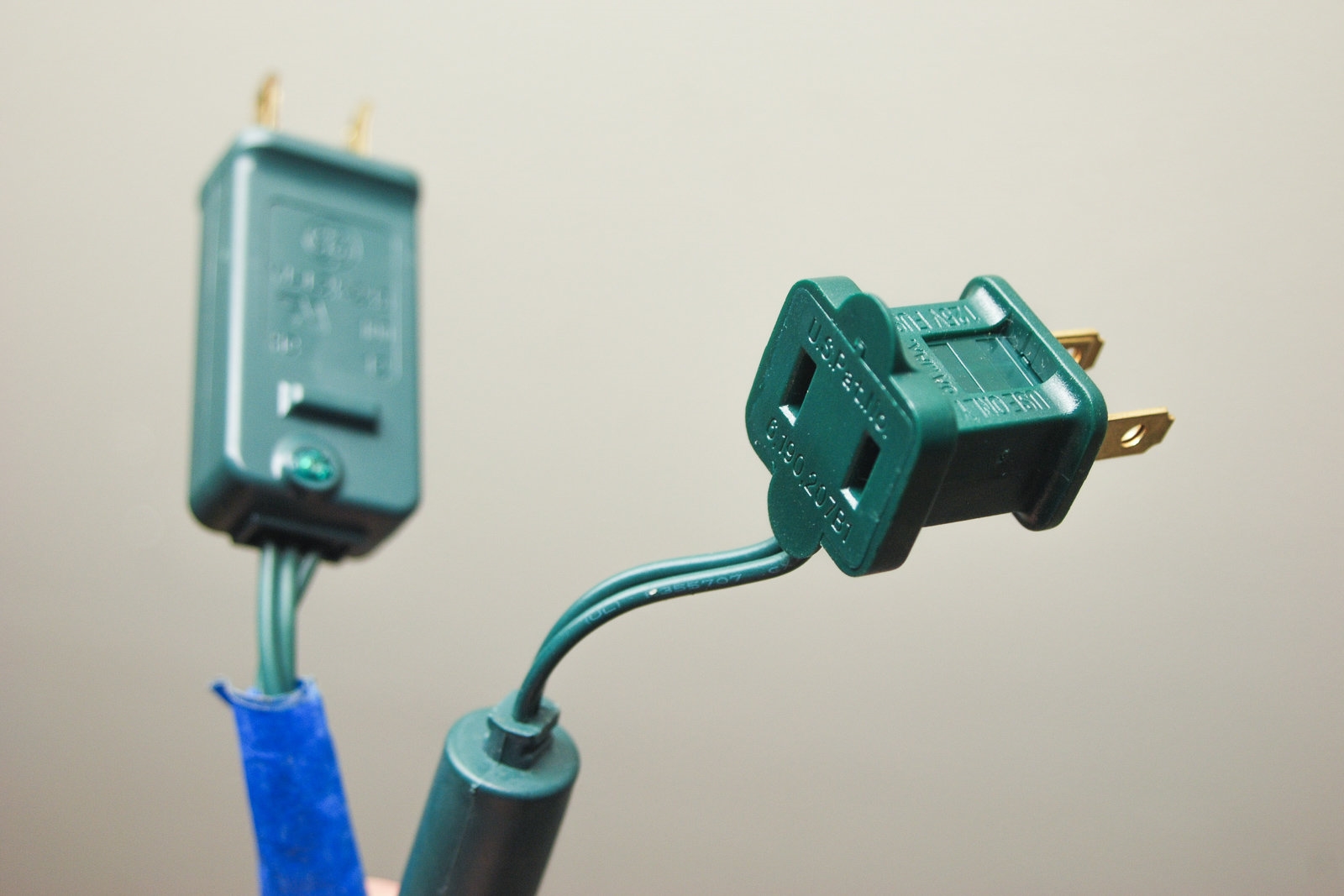
Christmas-light purists may be dismayed at the look of the purple GE Colorite bulb. In our tests, on the incandescent strands the purple bulb was a deep reddish/pink color, but on the Colorite strand it was a bright, vivid purple, almost a little “cartoony.” Once the strands are wound around a tree, we don’t think most people will pick up on this difference, but if you’re color sensitive, it’s something to be aware of. Our runner-up lights don’t have a purple bulb, so they don’t have the same issue.
Finally, we’ve discovered that Christmas lights are manufactured on a seasonal basis, so when they’re gone, they’re gone. For the past few years, these GE lights have sold out in early December and remained unavailable for the rest of the season.
Long-term test notes
After having the GE Energy Smart Colorite LED Miniature Lights on my tree every holiday season since 2014, I have no complaints. Just recently (fall 2017) I took them out of storage for the holidays, and all of the bulbs work fine. I’ve noticed that the wire stranding has loosened a little, but the lights are still fairly well organized, and I don’t foresee any issues with putting them around a tree.
Runner-up: Christmas Designers T5 Smooth LED Lights
If the GE Colorites are unavailable, we also like Christmas Designers T5 Smooth LED Lights(available in warm white, multicolor, and solid color). In our tests the color of the multicolor light set was very similar to that of the GE Colorites. The Christmas Designers warm whites lacked the overall warmth of the corresponding GEs but were still better than the rest. The wires of the Christmas Designers lights are tightly wound and easy to unravel and maneuver around a tree.
The multicolor Christmas Designers lights don’t have a purple bulb—they stick to blue, green, orange, and red—so they sidestep the problem that some people may have with the GE Colorite LEDs.
On average, these Christmas Designers lights are more expensive than the GE Colorites, but the company does offer bulk discounts, which can start to even things up or make them less expensive depending on the size of the order.
These lights are available in solid color strands, so they may be a better option if you’re looking to customize a display. In addition to the standard warm white and multicolor, strands are available in green, red, blue, or pure white.
Given that the GE Colorites have a history of running out of stock, we’re hopeful that the Christmas Designers lights will remain available.
Our pick for outdoor lights: Christmas Designers 5mm Wide Angle Conical LED Lights
The best lights for most outdoor displays are the 5mm Wide Angle Conical LED Lights from Christmas Designers. They are available in warm white, multicolor, or solid colors in a variety of lengths and bulb spacings (note that the 50-bulb lengths have a bulb spacing of 6 inches, not the more traditional 4-inch spacing of the 35-, 70-, and 100-bulb strands). These lights give off a bright, warm color that is perfect for just about anywhere outdoors, including a window box, a tree, a wreath, or a roofline. Like other LEDs, these lights cost more than incandescents, but since they’re specifically designed to withstand long-term exposure to moisture, your investment will be protected if they end up drooping into a puddle or a wet gutter. They also have a clean and tight wire, which in our tests made handling, hanging, and storing them easy. And because their electrical requirements are so low, you can connect a whopping 43 strands and run them on a single outlet before worrying about tripping a breaker; this reduces the need for extension cords, which can be a big hidden cost with larger exterior displays.
The odd shape of the 5 mm bulb gives these lights a distinctive appearance. Depending on how you view the bulb, the light emits a different level of brightness. In our tests, The Soapbox Studio’s Susan Moriarty picked up on this trait and liked it quite a bit, saying that it “gives the light strand a lot of different textures.” This aspect, combined with the bulbs’ brightness (which is much brighter than that of regular LED mini lights), makes them perfectly suited for outdoor displays.
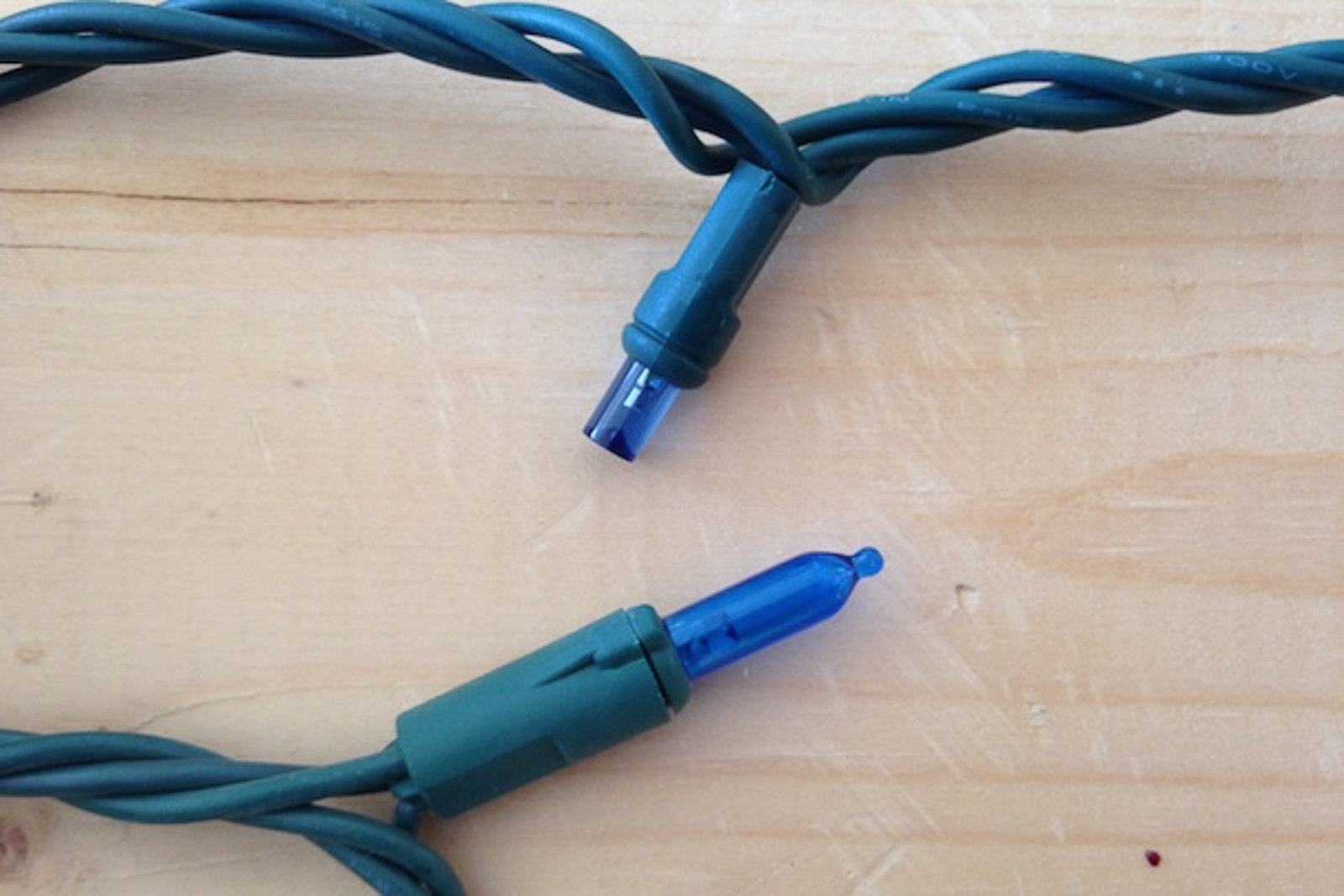
The Christmas Designers wide-angle lights have what are called molded bulbs—that is, each bulb is a completely sealed, one-piece unit. There is no separating the bulb from the wire, and thus no way for moisture or grime to work into the socket. According to Jason Woodward of Christmas Designers, that kind of moisture intrusion would “significantly reduce the life of a light set.” We tested this design by submerging the Christmas Designers multicolor strand in a bucket of water for an entire day. At no point did the lights show any ill effects from the test.
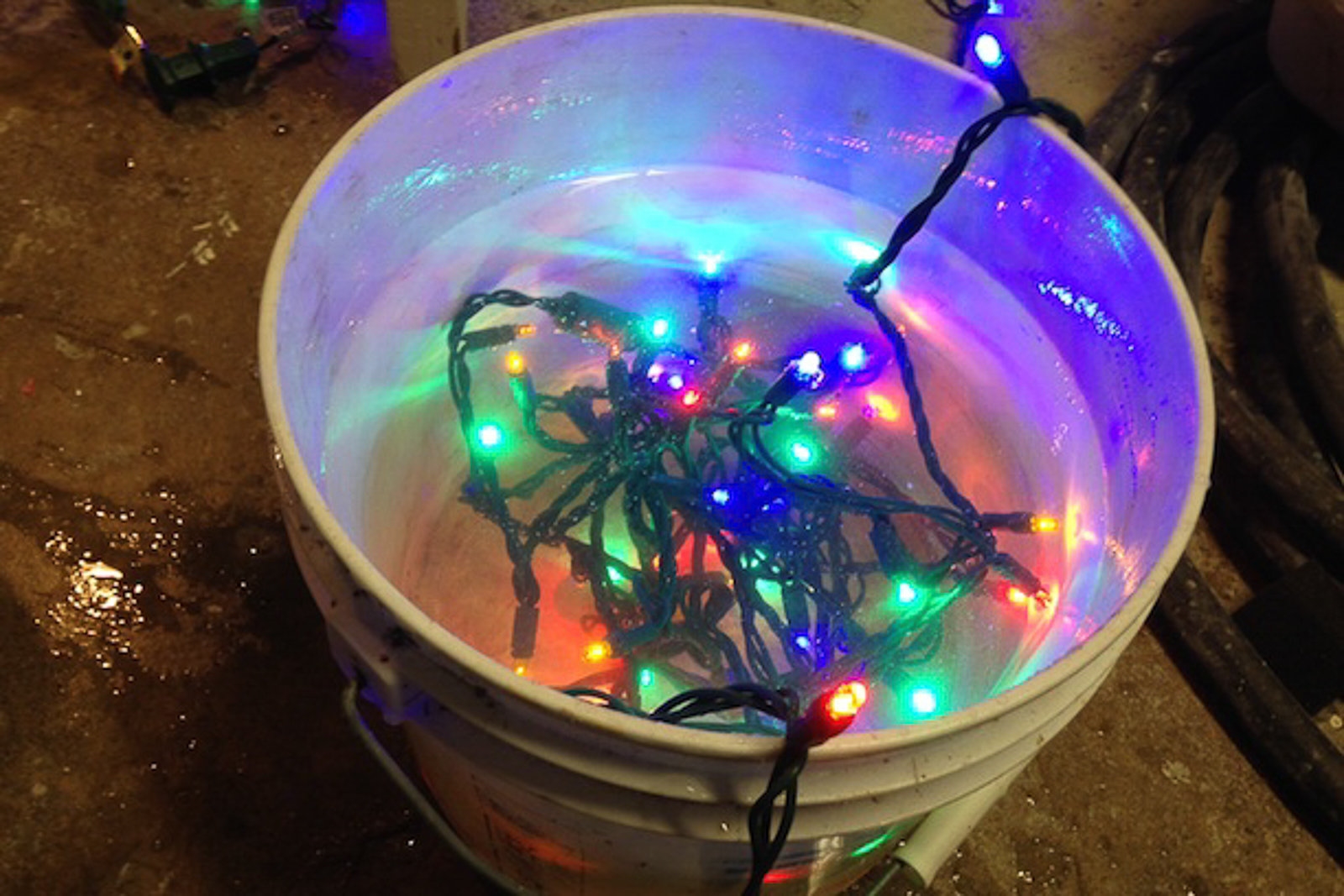
The molded-light design also means that you have no way to replace a bulb once it fails. Given the huge 75,000-hour rating on these LEDs, Woodward told us, “it’s very, very rare for one to go out.” If for some reason one does get damaged, the others will still operate, and in exterior applications you’re likely to find it a little easier to disguise an unlit bulb. As for overall lifespan, Woodward writes in a post on the company’s site that “you can reasonably expect to get at least 6 or 8 seasons of trouble-free service from a well-cared-for string of [exterior] LED Christmas lights.”5
Like the other lights from Christmas Designers, the wide-angle LEDs have a great wire—in our tests it was easy to unravel and required no twisting. The neat organization of the wires gave our test strands a high-quality feel.
These lights are also full-wave rectified, so you won’t have any issues with flickering. They’re compatible with dimmers, as well, and as Woodard told us, this feature also “gives you the advantage of being able to hook up to animation controllers such as Light-O-Rama,” something that he said is not possible with non-rectified lights.
Note too that in light of the company’s popularity with professional installers, Christmas Designers offers bulk pricing on its wide-angle lights.
Outdoor: Flaws but not dealbreakers
Aesthetically, the 5mm Wide Angle Conical LED Lights are limited. Because they’re so bright, we found them to be too overpowering for indoor use. The Soapbox Studio’s Susan Moriarty bristled at the idea of using them inside: “I don’t want to have to wear sunglasses while I’m looking at my Christmas tree,” she said. If you like your tree to be especially bright, these Christmas Designers lights are a great option, but we recommend that you purchase a single strand first and see for yourself before you take the plunge.
Runner-up, outdoor: Christmas Lights Etc Wide Angle 5mm LED Lights
If the Christmas Designers lights are sold out, we recommend the Wide Angle 5mm LED Lights from Christmas Lights Etc (available in a 50-bulb strand or a 70-bulb strand). In most ways, these lights are identical to the ones from Christmas Designers, with a molded-bulb design and a nice wire, but they’re simply not as bright. If it’s color that you’re after, these offer a nice, warm light.
Also great: Christmas Designers Incandescent Christmas Lights
LED Christmas lights are better for most people because they’re more efficient and more durable, but if you’re not ready to let go of the distinctive and traditional look of incandescents for indoor use, we recommend both the multicolored and white versions of Christmas Designers’s Incandescent Christmas Lights. These lights offer a great color quality that’s noticeable, particularly with the multicolor strand. In our tests the wires were tight and organized, and once we stretched them out, they lay flat and straight with no issues.
The rich hues of the Christmas Designers multicolor strand, especially the yellow-orange bulb, stood out against the competition. Because of a thick tint on the bulb, the color of the light was consistent for the entire length of the bulb. On the GE incandescents we tried, by comparison, the tinting wasn’t as strong, so the yellow color was washed out by the brightness of the filament, and the result looked like a regular bulb with a yellowish upper half. The effect wasn’t quite so apparent with the darker colors, but The Soapbox Studio’s Susan Moriarty immediately zeroed in on the yellow-orange as a high point of the Christmas Designers strand.
The white lights were harder to tell apart from the competition, but Moriarty still picked them out for having the best twinkle of the bunch. The difference here, though, was extremely slight, and we think anyone in a non-evaluation setting would find it nearly impossible to notice.
As for cost, these lights are about 10¢ a bulb at this writing, landing right in the middle of the incandescents that we tested.
Incandescent: Flaws but not dealbreakers
If there is a flaw to these lights, it’s simply that they’re incandescents. As Woodward writes in an article on the Christmas Designers website, “Incandescent bulbs are essentially designed to self-destruct. Running an electrical current through a filament eventually degrades the filament to the point of destruction.” Yes, the warm color and sparkle are wonderful and old-fashioned, but for only a slight compromise in those departments, LEDs are a much better choice for overall durability.
Incandescents also draw much, much more power than LEDs do, so Christmas Designers recommends connecting only three to six of these strands, depending on the length.
The competition
GKI/Bethlehem’s LEDs are nice lights, but we found that their color and wire quality didn’t match that of the GE or Christmas Designers lights.
The multicolor LED lights sold by Noma (known as Holiday Wonderland in the US) had a nice hue in our tests, but they’re non-rectified, so they have the potential for flicker—and if you merely jiggle them, they produce a dizzying strobe effect.
We also tested the Noma 5 mm wide-angle multicolored LEDs. Like the other Noma lights, this set is non-rectified. And because these lights employ a two-piece bulb and socket design, there is a chance of water infiltration, making them less than ideal for exterior applications.
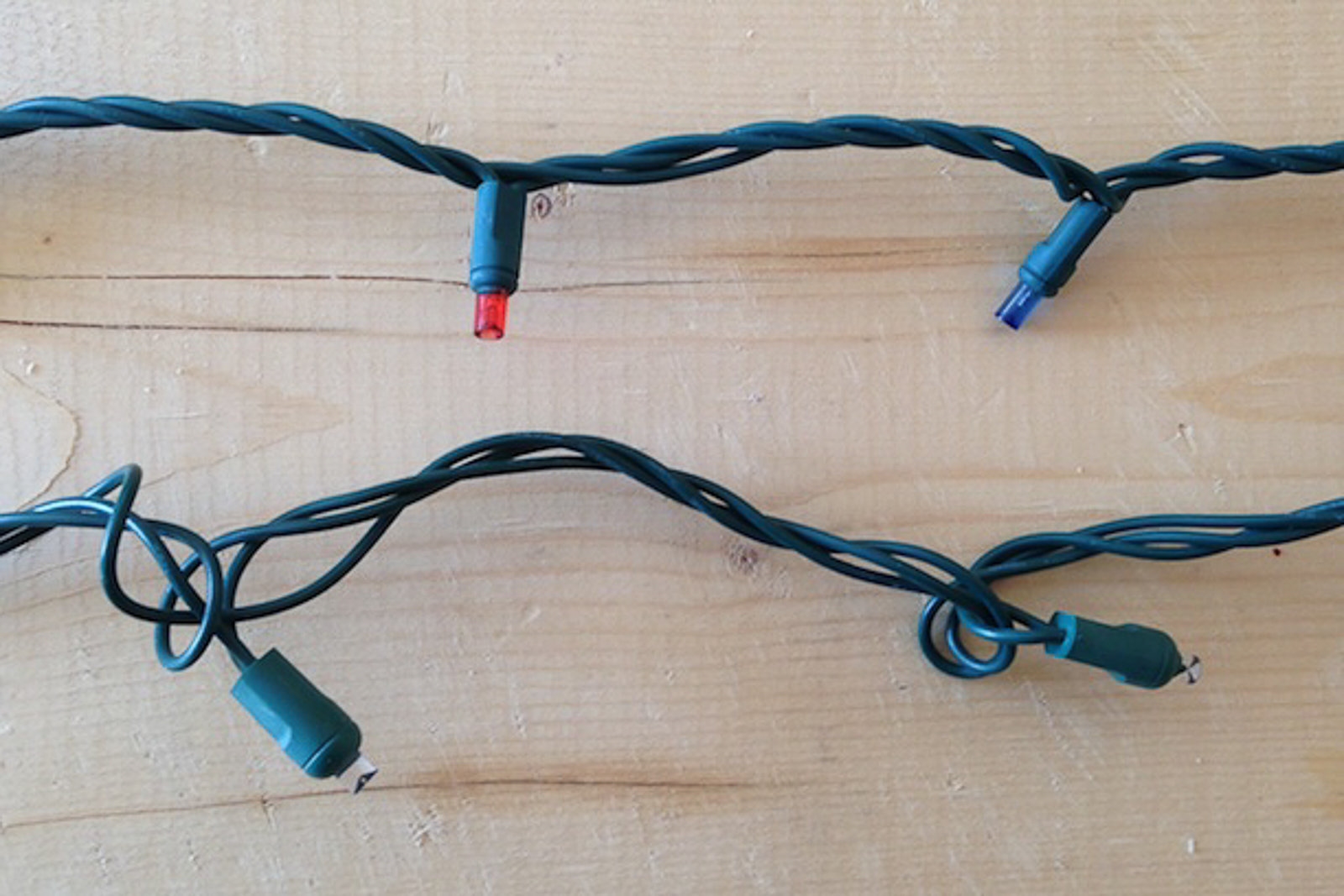
The wide-angle LEDs from Christmas Light Source had the most frustrating wire of all the lights we tested. Each bulb needed twisting and turning for the strand to lie flat, and even then it kept trying to spring back to how it was. The individual wires were loose from one another and had uneven loops. It was a nightmare to feed them through a tight spot like a railing or even between two branches.
The Brite Star clear incandescents we tested were very nice, and in light quality they were on a par with the strands from Christmas Designers and GE. We didn’t make them a recommendation because they have a 2½-inch spacing, which seems a little tight for most people. As we mention above, 4 inches is the standard.
What about larger bulbs (C7 and C9)?
For this guide, we dug deep only into mini lights, but you can find many other styles, both LED and incandescent, most notably the larger C7 and C9 bulbs. Judging from the consistently good lights that we discovered at Christmas Designers, if we were to purchase a few strands of larger bulbs, we would start with these Christmas lights—the larger bulbs you see on that page are updated with LED technology.
However, you should note that with larger bulbs, the LEDs are dimmer than incandescents, not brighter as they are with mini lights. As lighting installer Ben Orr told us, “For the people who like the look of the bigger bulbs along their roofline to really accent their home’s architecture, there is no comparing the light output of the traditional [incandescent] C9s to the LED C9s.” And for these, Christmas Lights Etc has a nice selection.
If you’re looking for full customization of your display, some specialty retailers, including Christmas Designers and Christmas Lights Etc, have what are called empty socket lines. You purchase a long roll of stranded sockets and your C7 or C9 light bulbs separately. After you cut the strand to length and attach the plug ends, you simply screw in the LED bulbs in whatever color pattern you like. Christmas Designers also sells its line by the foot.
We tested out the Christmas Designers empty socket line and were surprised at how easy it was to work with. Because you can cut the strand to whatever length you want, it’s a great choice for running lights along the eave of a roofline or a picket fence. We liked not having any excess length left over. Also, because you purchase the bulbs separately, the color patterns are entirely up to you. This arrangement is certainly a more advanced and time-consuming way to set up your lights, but if you’re working on a larger display, you’ll likely appreciate the flexibility that it provides.
If you just need to know what typical bulb sizes look like and what they’re called, try this: Bright Ideas, another light retailer, has a nice comparative image that can give you a sense of the common sizes.
What about cluster lights?
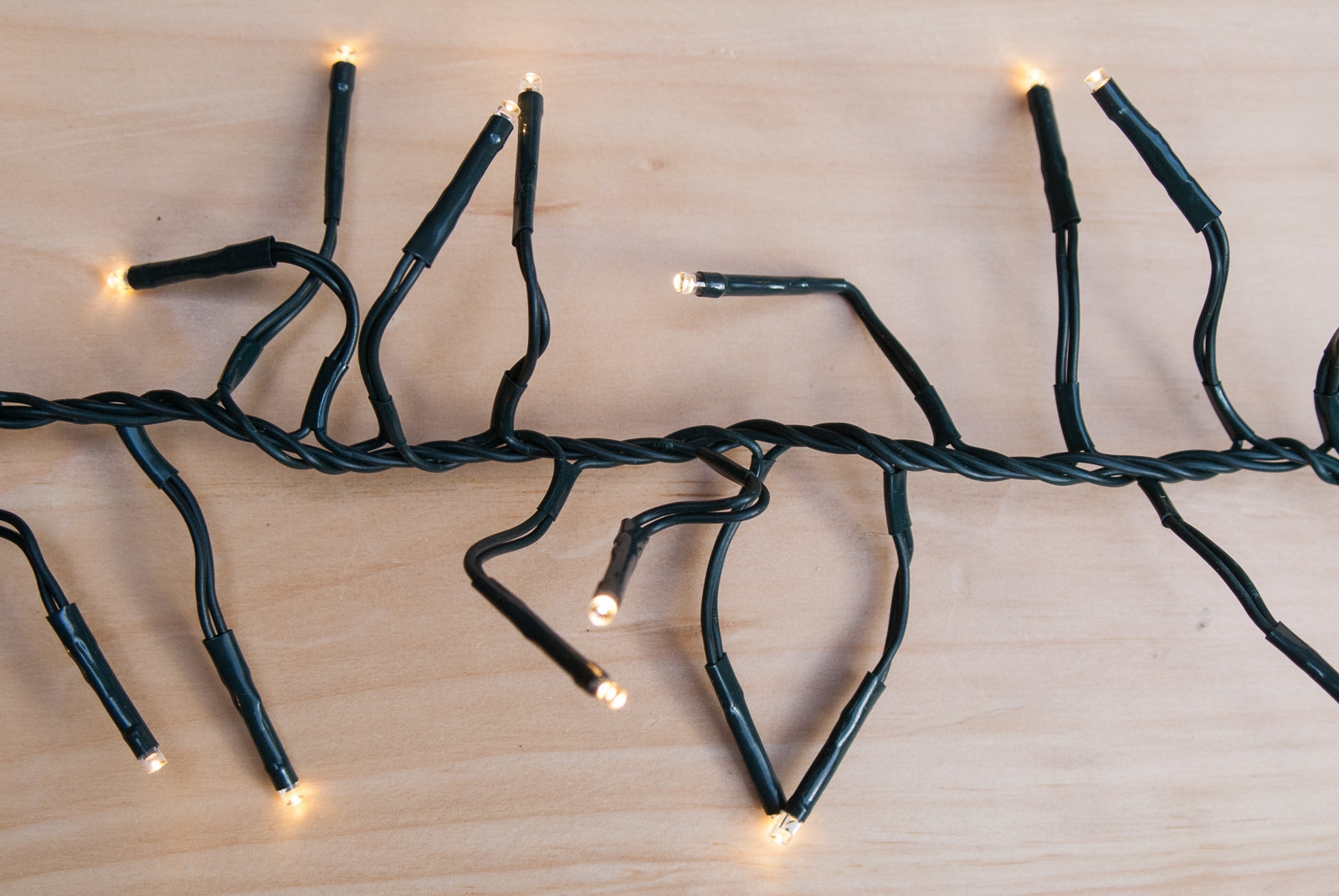
In 2016, we tested two different styles of cluster lights. Such strands, which have been popular in Europe for years, have much smaller bulbs (either 2 mm or 3 mm conicals) and a vastly higher bulb density—a 10-foot strand has almost 450 bulbs on it, in contrast to traditional mini lights, which might have only 50 bulbs on a 16-foot strand. With regular mini lights, the bulb is attached to the main wire, but on a cluster strand, the bulb sits on the end of a 2½-inch extension coming off the main wire. The spacing on these extensions can be as little as ? inch. On a tree, cluster lights offer a hazy, almost fairy-tale effect.
We found them available in two styles: straight strands and tree ready. The straight strands are self-explanatory, but the tree style is a little more complicated. This design—consisting of a central (non-lit) wire with a series of cluster strands coming off it, each one longer than the last—allows you to hang the main line vertically from the top of the tree (with the shortest cluster at the top) and then unravel each cluster around the tree. Lighting a tree this way takes hardly any time at all (this video shows the process). The lights are available for either 6-foot or 6.75-foot trees in warm or cool white.
Because of the raw number of LED bulbs on a strand, cluster lights are expensive compared with their traditional counterparts. A quality 10-foot strand costs about $35 at this writing, whereas our main recommendation, the 50-light GE Colorite strand, is 16 feet long and costs about $10.
If you are interested in cluster lights, we recommend sticking with a trusted retailer due to the variances we’ve seen with LED light quality. The ones we tested were from Christmas Designers, and these bulbs have the same warm incandescent-like look as the company’s other LED products.
What about smart Christmas lights?
In recent years, some manufacturers have started selling Christmas-light systems that you can control via a smartphone. These typically offer a wide variety of pattern and color options, all remotely controlled. We can see the appeal—especially if you’d like to turn outdoor lights on and off remotely while traveling, or if disconnecting your decorations means stepping out into the cold. But for a couple of reasons, most notably the cost and the lack of any feedback on long-term reliability, we’re not comfortable making a recommendation at this point.
The most promising of these systems is AppLights, a Home Depot exclusive. The line offers a wide variety of light styles, but the cost is significant: As of our research, a 24-bulb kit costs roughly $50 to $60. The reviews for the various AppLights are better than for most of the competition, but they’re still nothing spectacular, and a number of them come from the Home Depot Seed program, which offers products in exchange for reviews. Also, because this type of lighting system is relatively new, none of the reviews are more than a year old. This gives us very little sense of the system’s long-term durability.
There’s no doubt that this is an up-and-coming category, and it is one we will keep our eyes on. For now, we think the easiest, most reliable way to control your Christmas lights from your phone is to simply get a smart outlet and control the on/off (we’ve reviewed indoor models here). Or, if you’re looking to put on a more involved light show, well-respected systems such as Light-O-Rama are an option.
Is there lead in Christmas lights?
Thanks to a reader, we discovered that nearly all Christmas lights have lead in them. We researched this topic, though, and discovered that the dangers are minimal. Still, you can take a few steps to limit any exposure.
According to a WebMD article, lead is a relatively common ingredient in the PVC plastic sheathing that encases wires. The writer states that it “makes the plastic more flexible and reduces the risk of fire.” And it turns out that the presence of lead goes far beyond Christmas lights, as the article also points out that “nearly all appliance cords are covered in PVC that contains lead.” Jason Woodward of Christmas Designers writes in an article that trace amounts of lead can also be found in things such as extension cords, computer cords, batteries, and even some cosmetics. All of this explanation isn’t to justify lead’s existence in Christmas lights, but rather to add some context regarding its prevalence in many common household items (and ones that people handle far more often than Christmas lights).
According to the Occupational Safety and Health Administration, lead is harmful only if inhaled or ingested. It is not absorbed through the skin, so merely touching or holding Christmas lights doesn’t pose a risk. But as Woodward writes, trace amounts of lead can be transferred to the hands, so “the primary risk of absorbing lead after handling Christmas lights is through eating after handling the lights.”
The solution is an easy one: Simply wash your hands after stringing up the lights, or wear gloves while putting them on. It’s also important to minimize any exposure that young children might have with the lights; wee folk absorb lead at a higher rate than adults, and they’re more likely to put their hands in their mouths, thus ingesting lead.
Still, if you feel the need to go fully lead-free with your lights, we found a SafBaby article indicating that lead-free Christmas lights are sold at IKEA.
How to light a tree
You can find varying opinions on how many lights to use for your tree. In our interview, GE’s John Strainic suggested 100 lights per vertical foot. But 100 lights per foot strikes us as a lot, and we imagine that the result would be a very festive tree.
The box that the tested Brite Star lights came in goes a little lower, giving a number of 600 lights for an 8-foot tree (or 75 per foot). And this lighting calculator from Christmas Light Source indicates that 250 to 400 mini lights will light an 8-foot tree.
You have a couple of different ways to apply lights, but one method in particular gets a lot of praise. It involves putting the lights on from bottom to top, doing so vertically, going in and out as you move up. This technique puts the lights deep in the tree and creates depth and a warm interior. You can find more information from Real Simple and The Sparkle Queen. (If that approach sounds too radical, you can just do it the traditional way by circling the tree, working from bottom to top.)
This guide may have been updated by Wirecutter. To see the current recommendation, please go here.
When readers choose to buy Wirecutter’s independently chosen editorial picks, Wirecutter and Engadget may earn affiliate commissions.
(40)

